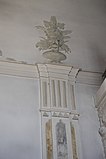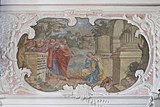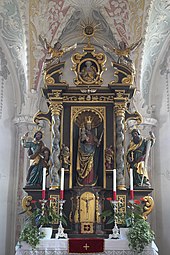St. Sebastian (Puch)
The Catholic branch church St. Sebastian in Puch , a district of Fürstenfeldbruck in the Upper Bavarian district of the same name , was built in the middle of the 15th century in the late Gothic style and renovated in the first half of the 18th century in the Baroque style. The church is dedicated to Saint Sebastian and Blessed Edigna von Puch , a French king's daughter who is said to have lived as a hermit in Puch in a hollow linden tree, the so-called Edignalinde . The church is one of the protected architectural monuments in Bavaria.
history
In 1453 the Pucher Church was consecrated. Between 1714 and 1724 the nave was redesigned and partially rebuilt. In 1765 the upper floor of the tower was built and in 1920 the top of the tower was renewed.
architecture
In the northern corner of the choir is the bell tower, the basement of which - like the sign with its star vault - still dates from the Gothic period. The single nave nave has a flat roof and is divided into three bays by pilasters with triglyphic capitals. The slightly retracted choir is covered by a needle cap barrel and is closed on three sides.
Piece
The stucco decor was created by Jacopo Appiani in 1724 . The ceilings in the choir and in the nave are covered with stucco stucco and bandwork, the ceiling paintings are framed by elaborate stucco frames. The walls are decorated with stucco vases, the windows are framed by rocaille ornaments . The stitch caps in the choir rest on consoles with floating angels holding draperies. The coats of arms of the Fürstenfeld abbot Liebhard Kellerer and the court judge Georg Rott can be seen in the two stucco cartouches on the choir arch . The stucco reliefs in the reveal of the choir arch are interpreted as an allusion to the coat of arms of Abbot Liebhard Kellerer. The flat stucco relief on the underside of the organ gallery is supposed to represent paradise .
Ceiling painting
The large ceiling paintings in the choir and nave are dedicated to the blessed Edigna. The depiction of the Assumption of Blessed Edigna in heaven and the smaller, oval ceiling paintings in the nave, which contain quotations from the Bible and emblematic depictions, date from around 1730 and are attributed to the painter Joseph Krenauer. The two gallery pictures , Jesus and the Samaritan woman and the healing of the daughter of the Canaanite woman, were probably also made by Joseph Krenauer at the same time. The nave painting was renewed in 1936 by Michael Gottschalk.
Furnishing
- The high altar from 1867 is flanked by the sculptures of the apostles Peter and Paul . In the central niche, a Madonna and Child is shown standing on the crescent moon. To the side are the statuettes of Blessed Edigna and Saint Sebastian from the first half of the 18th century.
- The two side altars date from the 19th century. The altarpiece of the north side altar depicts Blessed Edigna, while St. Sebastian is depicted on the south altarpiece.
- Numerous votive pictures remind us that after the bones of Blessed Edigna were buried in a side altar in 1600, the Pucher Church became the destination of a pilgrimage.
literature
- Georg Dehio : Handbook of German Art Monuments - Bavaria IV - Munich and Upper Bavaria . 2nd edition, Deutscher Kunstverlag , Munich 2002, ISBN 3-422-03010-7 , pp. 989–990.
- Volker Liedke, Peter Weinzierl: District Fürstenfeldbruck (= Bavarian State Office for Monument Preservation [Hrsg.]: Monuments in Bavaria . Volume I.12 ). Karl M. Lipp Verlag, Munich 1996, ISBN 3-87490-574-8 , p. 96-98 .
Web links
- Puch, St. Sebastian Warburg Institute Iconographic Database
Individual evidence
- ^ History of the parish of St. Magdalena. The branch church of St. Sebastian and the Sel. Edigna in Puch Archdiocese of Munich and Freising, Fürstenfeld Parish Association
- ↑ List of monuments for Fürstenfeldbruck (PDF) at the Bavarian State Office for Monument Preservation, monument number D-1-79-121-56
Coordinates: 48 ° 11 ′ 15.3 " N , 11 ° 13 ′ 15.7" E
















